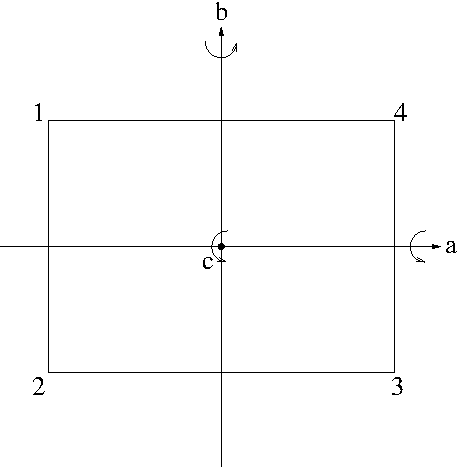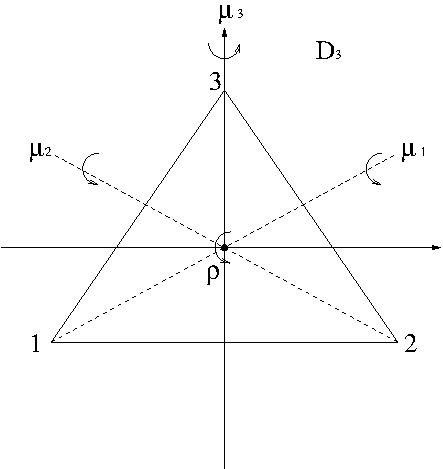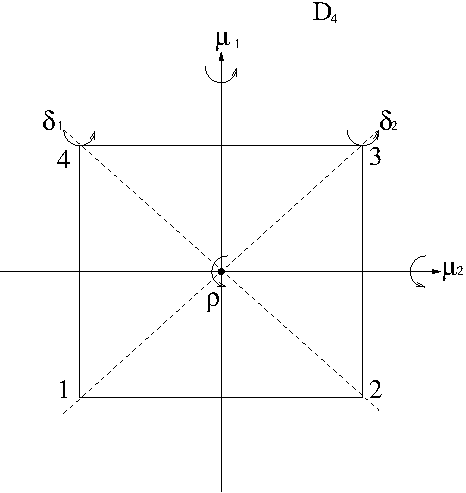In this lecture, we study maps from a group into another group that carry over the same group structure i.e preserve group operations. Such maps are called homomorphisms. It turns out that it suffices to require a homomorphism to preserve a binary operation only. Then the unary operation (inverses) and the nullary operation (the identity element) are automatically preserved.
Definition. Let $(G,\ast)$ and $(G’,\sharp)$ be two groups. A map $\varphi: G\longrightarrow G’$ is called a homomorphism if $\varphi(a\ast b)=\varphi(a)\sharp\varphi(b)$.
Example. Define $\varphi: (\mathbb{R}^+,\cdot)\longrightarrow(\mathbb{R},+)$ by
$$\varphi(x)=\log_{10}x,\ \forall x\in\mathbb{R}^+.$$
Then $\varphi$ is a homomorphism. In addition, $\varphi$ is one-to-one and onto. A homomorphism which is one-to-one and onto is called an isomorphism. If there is an isomorphism from a group onto another group, they are the same group meaning we do not distinguish them.
Example. The map $\varphi: \mathbb{Z}\longrightarrow\mathbb{Z}_n$ defined by
$$\varphi(x)=[x],\ \forall\ x\in\mathbb{Z}$$
is a homomorphism called the canonical or the natural homomorphism. The canonical homomorphism is onto.
Example. Let $G$ be a group and $A(G)$ the set of all bijective (i.e. one-to-one and onto) maps of $G$ onto itself. Recall that $A(G)$ forms a group with composition. Let $a\in G$. Define $T_a: G\longrightarrow G$ by
$$T_ax=ax\ \forall\ x\in G.$$ Hence $\forall a\in G$, $T_a\in A(G)$. Furthermore, $\forall a,b\in G$, $T_aT_b=T_{ab}$: $\forall x\in G$,
$$T_aT_b(x)=T_a(T_bx)=T_a(bx)=a(bx)=(ab)x=T_{ab}x.$$
Define $\varphi: G\longrightarrow A(G)$ by
$$\varphi(a)=T_a,\ \forall\ a\in G.$$ Then $\varphi$ is a homomorphism. In addition, it is one-to-one. If $|G|=n$, then $|A(G)|=n!$, so $\varphi$ cannot be onto.
Definition. A homomorphism which is one-to-one (injective) is called a monomorphism. A homomorphism which is onto (surjective) is called an epimorphism. A homomorphism which is one-to-one and onto (bijective) is called an isomorphism as mentioned above. $G$ is said to be isomorphic to $G’$ if there exists an isomorphism from $G$ onto $G’$. If $G$ is isomorphic to $G’$, we write $G\cong G’$. An isomorphism from a group $G$ onto itself is called an automorphism.
Theorem. [Cayley’s Theorem] Every group $G$ is isomorphic to some subgroup of $A(S)$, for an appropriate set $S$.
We in fact proved this theorem in the previous example by taking $S$ to be the group $G$ itself. But there may be other choices for $S$. If $G$ is finite, $S$ may be taken to be a finite set in which case $A(S)$ is $S_n$, the group of permutations of $\{1,2,\cdots,n\}$. In this case, Cayley’s Theorem is stated as: A finite group can be represented as a group of permutations.
Example. Let $G$ be a group and $a\in G$ be fixed. The map $\varphi: G\longrightarrow G$ defined by
$$\varphi(x)=a^{-1}xa,\ \forall x\in G$$
is an automorphism called the inner automorphism of $G$ induced by $a$.
Example. Define $\varphi: (\mathbb{R},+)\longrightarrow (\mathbb{C}\setminus\{0\},\cdot)$ by
$$\varphi(x)=e^{ix},\ \forall x\in\mathbb{R}.$$
While $\varphi$ is a homomorphism, it is neither one-to-one nor onto.
Lemma. Let $\varphi: G\longrightarrow G’$ be a homomorphism. Then
(a) $\varphi(e)=e’$.
(b) $\varphi(a^{-1})=\varphi(a)^{-1}$.
Proof. (a) Let $a\in G$. Then $ae=a$. Since $\varphi$ is a homomorphism, $$\varphi(ae)=\varphi(a)\varphi(e)=\varphi(a)=\varphi(a)e’.$$ So by the cancellation law, we obatin $\varphi(e)=e’$.
(b) Let $a\in G$. Then
\begin{align*}
\varphi(a)\varphi(a^{-1})&=\varphi(aa^{-1})\ (\mbox{because $\varphi$ is a homomorphism})\\
&=\varphi(e)\\
&=e’\ (\mbox{by part (a)})
\end{align*}
Hence, $\varphi(a)^{-1}=\varphi(a^{-1})$.
Lemma. Let $\varphi: G\longrightarrow G’$ be a homomorphism. Then $\varphi(G)\leq G’$.
In here, the kernel of a function was introduced. Let $\varphi: G\longrightarrow G’$ be a homomorphism and $K=\varphi^{-1}(e’)=\{a\in G: \varphi(a)=e’\}$. Then $\ker\varphi$ and $K=\varphi^{-1}(e’)$, the preimage of $e’$ under $\varphi$ are closely related as:
\begin{align*}
(a,b)\in\ker\varphi&\Longleftrightarrow\varphi(a)=\varphi(b)\\
&\Longleftrightarrow\varphi(ab^{-1})=e’\\
&\Longleftrightarrow ab^{-1}\in K.
\end{align*}
So, in group theory we define $K=\varphi^{-1}(e’)$ to be $\ker\varphi$, the kernel of $\varphi$.
Theorem. $\varphi: G\longrightarrow G’$ is one-to-one if and only if $\ker\varphi=\{e\}$.
Proof. ($\Rightarrow$) Suppose that $\varphi$ is one-to-one and let $a\in\ker\varphi$. Then $\varphi(a)=\varphi(e)=e’$. Since $\varphi$ is one-to-one, $a=e$.
($\Leftarrow$) Suppose that $\ker\varphi=\{e\}$ and let $\varphi(a)=\varphi(b)$. Then
\begin{align*}
\varphi(ab^{-1})=e’&\Longrightarrow ab^{-1}\in\ker\varphi\\
&\Longrightarrow ab^{-1}=e\\
&\Longrightarrow a=b.
\end{align*}
So, $\varphi$ is one-to-one.
Theorem. Let $\varphi: G\longrightarrow G’$ be a homomorphism. Then $\ker\varphi\leq G$.
Theorem. Let $K=\ker\varphi$. Then $\forall a\in G$, $aK=Ka$.
Proof. It suffices to show (why?) that $\forall a\in G$, $a^{-1}Ka\subset K$. Let $a\in G$. Then $\forall k\in K$,
$$\varphi(a^{-1}ka)=\varphi(a)^{-1}\varphi(k)\varphi(a)=e’\Longrightarrow a^{-1}ka\in K.$$



